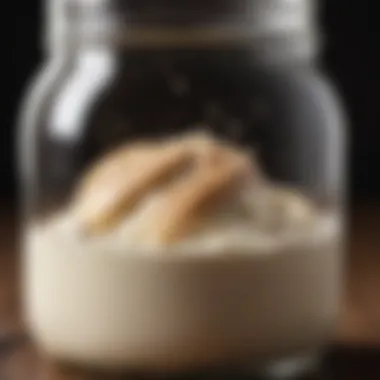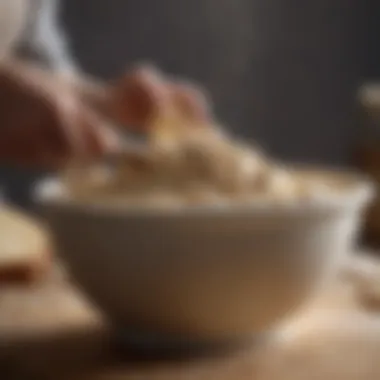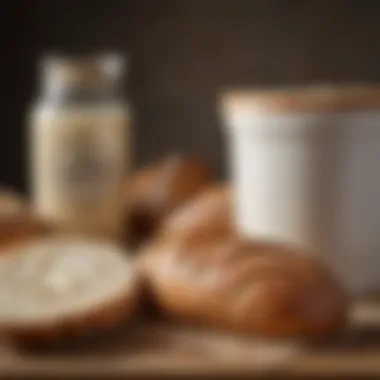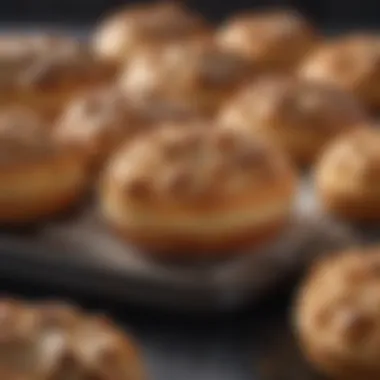Understanding Sourdough Starter: Your Ultimate Guide


Intro
Sourdough starter is the essence of traditional baking. It serves as both the leavening agent and the flavor foundation for many baked goods. Understanding the intricacies of sourdough starter is essential for any aspiring baker or culinary enthusiast. This guide delves into the fundamental aspects of sourdough starters, focusing on the fermentation process, maintenance techniques, and practical uses in various recipes.
The sourdough starter has an undeniable role in elevating the quality of bread. Not merely a loaf enhancer, it offers depth of flavor and greater nutritional profile to baked goods. Therefore, mastering sourdough starter opens doors to a whole world of culinary possibilities. Here, you'll discover not just how to make your own starter but how to maintain it for delicious and consistent results.
Let's delve into the highlights, instructions, and techniques that form the backbone of sourdough baking.
Preamble to Sough Dough Starter
Sough dough starter serves as the backbone of sourdough baking. Understanding its importance enhances both flavor and texture in baked goods. Unlike conventional yeast, sourdough refers to a natural technique that harnesses wild yeast and lactic acid bacteria from the environment to create a lively fermentation culture. The starter not only elevates bread-making but also offers a unique flavor profile that makes every loaf distinctive. Hence, mastering this craft is vital for any aspiring baker.
Definition and Significance
A sourdough starter is a mixture of flour and water that fosters the growth of wild yeast and beneficial bacteria. When left at room temperature, it ferments naturally, producing gas and creating a rise in your bread. This process is crucial in developing that characteristic tangy flavor and nutty aroma associated with sourdough bread. The significance of understanding the starter lies in its ability to convert simple ingredients into a complex and delectable final product. Proper handling and nurturing of the starter ensures consistent baking results and brings out the rich flavors.
Historical Context
The origins of sourdough date back thousands of years, making it one of the oldest forms of leavening. Its history traces from ancient civilizations, particularly in regions such as Egypt, where they practiced fermenting flour and water. People relied on natural yeasts found in their own environment. This traditional method has persisted, even in today's high-tech world. The growing trend of artisanal cooking has revived interest in sourdough starter. Furthermore, the recent focus on home baking during challenging times highlighted its importance as an accessible and rewarding technique. This understanding situates the sourdough starter not just as a baking essential but as a part of culinary heritage.
The Science Behind Sough Dough Starter
Understanding the underlying science of sourdough starter is crucial for both novice and seasoned bakers. This section delves into the mechanics of fermentation, examining the microorganisms involved and their roles. Gaining this knowledge can dramatically improve your baking outcomes and help you appreciate the intricate art of creating sourdough.
Fermentation Process Overview
Fermentation is the cornerstone of sourdough baking. In simple terms, fermentation is the biochemical reaction that transforms flour and water into the starter. It involves the conversion of sugars into alcohol and acids by microorganisms, primarily yeast and bacteria. As these elements interact, they create a complex environment that flavors the dough, develops texture, and enhances shelf life.
The process typically unfolds in stages. Initially, the blend of flour and water invites wild yeasts and bacteria from the environment. They begin feeding on the available sugars from the flour. As fermentation progresses, these microorganisms multiply, producing tiny bubbles of carbon dioxide. This activity is what gives sourdough its distinctive rise and airy structure. Overall, the fermentation stage lasts from several hours to days, depending on environmental conditions.
Microorganisms Involved
The fermentation process hinges on multiple species, primarily wild yeast and lactic acid bacteria. Wild yeast, notably Saccharomyces cerevisiae, is the primary player, driving much of the fermentation.
Some key fungal organisms include:
- Pichia, known for its robust ability to endure lower pH levels.
- Candida, which can also regularly be found in active starters but may emit several factors influencing aroma.
Meanwhile, lactic acid bacteria, such as Lactobacillus, revel in sourdough. These bacteria create a tangy flavor profile as they convert sugars into lactic acid. This vibrant interplay between yeast and bacteria is what sets sourdough apart from conventional bread.
Role of Wild Yeast and Bacteria
Both wild yeast and bacteria play complementary roles in developing the sourdough flavor and texture. Wild yeast impacts the dough's rising capability. It does so by converting sugar into carbon dioxide and alcohol, creating a light structure in the finished product.


On the other hand, bacteria regulate this alcoholic fermentation, contributing lactic acid, which presents the drink's acidity. It results in the characteristic tanginess found in sourdough. Ultimately, the balance achieved between these microorganisms shapes each starter's unique personality.
In summary, The science behind sourdough starter is what makes it both an art and a craft. Understanding these fermentation processes and the roles of microorganisms allows bakers to harness their potential more effectively, translating into higher-quality, flavorful loaves.
The Basics of Creating a Sough Dough Starter
Creating a sourdough starter is a crucial step that lays the foundation for successful sourdough baking. This section focuses on the necessary ingredients, a detailed step-by-step process for creation, and important storage considerations. A well-prepared starter can enhance the overall quality of your baked goods, ensuring flavor and texture are maximized.
Necessary Ingredients
To begin the sourdough starter journey, certain ingredients are essential. Primarily, you'll need flour and water, but understanding the type of flour is critical since it significantly affects the starter's effectiveness.
- Flour: Bread flour is usually preferred because of its higher protein content, which contributes to a stronger gluten structure. However, whole wheat flour or rye flour can be beneficial too, as they contain more nutrients that foster the development of wild yeast.
- Water: Use filtered or dechlorinated water to prevent any chemical interference that could impact fermentation. Temperature is also key—room temperature water aids the fermentation process, while colder water can slow it down.
- Time: While it's not a traditional ingredient, sufficient time is necessary to allow fermentation to take place. Patience is as important as the ingredients themselves.
Step-by-Step Creation Process
Creating a sourdough starter is straightforward, but attention to detail during this process can yield better results. Follow these steps:
- Combine Ingredients: In a clean glass or plastic container, mix equal parts flour and water by weight. For example, you may start with 100 grams of flour and 100 grams of water.
- Mix Thoroughly: Stir the mixture until there are no dry remnants of flour. A thick batter-like consistency is ideal to start off your starter.
- Initial Fermentation: Cover the container loosely with a lid or a clean cloth. This allows gases to escape while protecting the mixture from debris. Leave it at room temperature for 24 hours.
- Feeding: Before the next fermentation phase, discard half of the mixture to maintain balance. Afterwards, feed it with fresh flour and water in the same proportion. Repeat this process every 24 hours for 5–7 days.
- Look for Bubbles: Actively observe gas bubbles and a sour aroma developing, which indicate the starter is alive and thriving. Once it doubles in size within about 4 to 6 hours of feeding, you have created a viable sourdough starter.
Storage Considerations
Proper storage of your sourdough starter is essential for its longevity and vitality. Here are some important considerations:
- Short-Term Storage: If you plan to bake frequently, keeping your starter at room temperature and feeding it daily is ideal. Always remember to feed it before you use some for your baking needs.
- Long-Term Storage: If you don’t plan to bake often, you can store the starter in the refrigerator. Transition it into cold storage by feeding it to establish a strong base, then refrigerating it. For best results, feed it at least once a week.
- Resuming Activity: When you return to baking, take the starter out a day prior. Resume your feeding schedule to reactivate and boost its strength.
A well-maintained sourdough starter can last indefinitely, allowing bakers to create delicious loaves and recipes for many years.
The process of creating a sourdough starter can seem arduous, but the end result is worth the commitment. By understanding the ingredients, diligently following the steps, and addressing storage protocols, you ensure a robust and versatile starter that will enhance your baking pursuit.
Maintaining Your Sough Dough Starter
Sough dough starter is a vital part in baking artisan breads. It needs consistency and care to thrive. Maintenance plays a crucial role in ensuring that the starter remains active and healthy. When you maintain a sourdough starter, you enhance its strength and flavor. It's not just a task; it's part of the journey of developing your baking craft. With the right techniques, your sourdough can produce extraordinary results.
Feeding Strategies
The feeding process is essential for a robust sough dough starter. Regularly providing fresh flour and water replenishes nutrients, enabling the fermentation process. Common strategies include:
- Daily Feeding: For starters kept at room temperature. This method typically requires equal weight of flour and water.
- Weekly Feeding: For those stored in the fridge. Allow the starter to warm up to room heat before feeding.
- Hydration Levels: Adjust between 100% and 75%, depending on desired texture.
Using whole grains, such as whole wheat or rye flour, can offer additional nutrients, aiding in the overall vitality of the starter. Mixing in these flours can introduce the wild yeasts needed for a better rise and unique flavor profile.
Monitoring Health and Activity
Observation plays a significant role in maintaining your starter. An actively fermenting starter will double in size within a few hours after feeding. Important signs include:


- Bubbles Formation: Indicates a healthy fermentation.
- Rise and Fall: The starter should rise and eventually collapse back down, indicating peak activity.
- Smell Sensations: A pleasant, slightly aerobic odor suggests good health. A sour or off smell may indicate issues.
It's good practice to conduct a float test to check the starter's readiness for baking. Take a small spoonful and drop it in a glass of water. If it floats, it is ready; if it sinks, it needs more time or feeding.
Common Challenges and Solutions
Maintaining a sourdough starter doesn't come without obstacles. Understanding potential issues helps resolve them efficiently. Common challenges may involve:
- Separation: Wilted or watery liquid forms on top.
- Sluggish Growth: Lack of bubbles or rise.
- Contamination: Unpleasant colors or textures emerging.
- Solution: Stir it back in and feed as usual. Regular feeding will ease this problematic separation.
- Solution: Increase feeding frequency or adjust the flour type used.
- Solution: Discard the contaminated portion and troubleshoot environmental factors like temperature and cleanliness.
Proper upkeep can prolong the life of your sourdough starter. With understanding and effort, it can become a recurring staple in your baking journey.
Attending to the needs of your sourdough starter not only matters for everyday usage but lays a strong foundation for various recipes, and you'll come across tasty surprises that enhance your baking tradition. By integrating these practices, bakers can offset typical challenges while developing their flavor profiles in becoming proficient sourdough enthusiasts.
Using Sough Dough Starter in Baking
Using sourdough starter in baking is more than a trend; it is a foundational skill for any passionate baker. This process contributes depth and complexity to various baked goods. Ditching commercial yeast, sourdough relies on naturally occurring microoganisms cultivated in a starter. The benefits are numerous, including enhanced flavor, texture, and a healthy ingredient profile.
Incorporating into Recipes
Incorporating sourdough starter into recipes transforms standard approaches and results in interesting flavors. This element hydrated with water and mixed with flour can be added to many traditional recipes. Use it in bread formats like baguettes, loaves, or rolls. Additionally, adjust your amounts of flour and liquid accordingly to maintain balance in texture and flavor. Consider using two distinct approaches:
- Partial Replacement: Substitute a portion of your yeast in regular bread recipes with a mature starter, allowing the dough to develop more flavor.
- Full Replacement: In specific recipes like sourdough focaccia or pancakes, replace all dry ingredients with the starter, allowing wondering textures.
Experiment with what fits best for you and your taste. Always remember that timing is vital in these processes since flour types and humidity levels can affect taste.
Texture and Flavor Contributions
The role of sourdough starter culminates in its rich contributions to texture and flavor. The naturale fermentation leads to air pockets that result in a well-leavened loaf. Combined with the time factor in breadmaking, this allows gluten to develop fully, yielding a softer crumb.
The flavor develops deeper, providing a pleasant tang that contrasting bakery yeasts cannot match. Specific compounds like lactic acid and acetic acid emerge during the fermentation process to elevate the baking experience. Thus:
- Crust: A thick, crunchy crust forms, providing significant response to heat.
- Crumb: A slightly chewy crumb is desirable; the initial fermentation equipment creates subtle notes of sourness.
Embrace the possibilities with sourdough. Its contribution isn’t just functional — it’s an art form.
Exploring Recipe Options with Sough Dough Starter


Exploring recipe options with sourdough starter is fundamental not only for expanding the versatility of this ingredient but also for elevating baked goods to new heights. Sourdough starter provides a depth of flavor and a unique texture that cannot be replicated with commercial yeast. Understanding how to utilize this starter opens a world of culinary possibilities, making it a precious tool in a cook's arsenal.
Natural fermentation imparts complexity to breads, pastries, and numerous other dishes, enhancing their flavor profiles. Besides traditional baking, the collaboration between wild yeast and lactic acid bacteria in your starter can create sumptuous items categorized outside conventional bread-making. It is advantageous to embrace this diverse nature of sourdough starter.
Recipe exploration may seem daunting, but the ability to incorporate this starter is a catalyst for creativity in the kitchen.
Sourdough Bread Recipes
Creating sourdough bread is perhaps the most rewarding way to use your starter. The classic sourdough has unique characteristics that are why it remains a favorite among bakers. The combination of depth of flavor and distinctive crust is unparalleled.
When embarking on this process, several essential steps and ingredients come into play:
- Choosing Flour: Opt for strong flour, such as bread flour, which contains higher protein content for better structure.
- Hydration Level: If you prefer an open crumb texture, incorporate a higher hydration in your dough.
- Bulk Fermentation: During this stage, allow your dough to rise at room temperature, capturing the yeast's activity effectively.
- Shaping and Scoring: Shape the dough carefully and score it properly before baking for aesthetic appeal and aiding the oven spring.
By consistently practicing these techniques, you will aid your starter in evolving, ultimately improving the quality of your bread alongside the satisfaction from mastering a fundamental culinary skill.
Other Interesting Applications
Sourdough starter can find itself contributing to a variety of recipes beyond bread, showcasing its versatility.
Here are some distinct usages:
- Pancakes and Waffles: Incorporating sourdough starter into breakfast treats creates an enjoyable soft interior and crispy exterior.
- Pasta: A tangy flavor emerges when using sourdough in handmade pasta recipes.
- Pizza Dough: Utilizing sourdough for pizza dough allows for a chewy and flavorful base, elevating your pizza nights hastily.
- Crackers: A great leftover option is sourdough crackers; they can provide a crisp snack with some delightful seasoning.
Each diverse application not only illustrates the flexibility of sourdough, but also invites bakers to experiment and cater better to their tastes and preferences. Bastion of culinary innovation asserts itself through the capability of the sourdough starter—not just an ally for bread makers, but a prominent fixture for anyone interested in expanded gastronomic exploration.
"Sourdough is more than just bread; it's an ingredient for limitless creativity."
The End
Well-understood sourdough starter unlocks better baking. This concluding segment emphasizes key aspects that make sourdough starter impactful not just in culinary arts but also in personal discovery.
Summary of Key Points
Sourdough starter has various benefits and features that improve baking:
- Foundation of Sourdough: It’s essential as it replaces commercial yeast.
- Flavor Development: Creates complex tastes that commercial yeast cannot mimic.
- Durability: A well-maintained starter can last indefinitely with proper care.
- Health Aspects: The fermentation process breaks down gluten and increases digestibility.
- Adventure in Baking: It fosters creativity and invites trial in different recipes.
Each point shows that incorporating a sourdough starter enhances both the baking process and the outcomes.
Encouragement for Experimentation
Embracing the sourdough starter is not merely with maintaining it. Testing unique approaches adds personal creativity.
- Try New Ingredients: Consider using whole grains, alternative flours, or even unexpected fruits.
- New Techniques: Shift the fermentation time and observe the flavor shifts.
- Collaborate: Join communities online, like those on reddit.com, for more shared keysteps and tips.
Sourdough baking from starter is an evolving journey. All bakers and enthusiasts are encouraged to experiment beyond basics and syntheize novel techniques. This forms a thriving baking culture,
"Great baking happens when combining science with personal touch."
In closing, excellent comprehension culminates with substitutes, trials, and creativity alongside one's sourdough starter.







